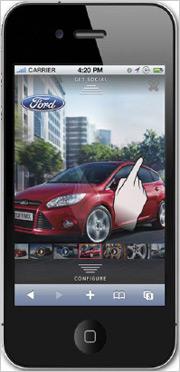Commentary
Marketers Still Not Thinking Mobile-First
- by Mark Walsh @markfwal, April 16, 2014
 More than half (57%) of U.S. smartphone owners who see in-app ads find them interruptive, and only 20% think the ads are relevant to them, according to a new Forrester
report on the future of mobile advertising.
More than half (57%) of U.S. smartphone owners who see in-app ads find them interruptive, and only 20% think the ads are relevant to them, according to a new Forrester
report on the future of mobile advertising. That finding, among others, suggests marketers still aren’t delivering campaigns tailored to the unique requirements of mobile, argues analyst Jennifer Wise. The smaller screen and user focus on utility means advertising content has to be immediate, simple and contextually relevant. And too often it’s simply a tiny version of what’s on the desktop.
She points to some of the barriers holding back higher mobile ad spend: a lack of standards for mobile tracking, device fragmentation, still evolving creative formats, and a tangle of vendor solutions that all promise big results but are difficult to compare because they may only work with specific platforms and have proprietary technologies.
Instead of looking to ad tech for answers, Wise says marketers have to focus on using mobile-specific formats coupled with sophisticated targeting to run effective mobile campaigns. In that vein, the report predicts four different types of display units emerging: standard display, mobile-specific formats, publisher-specific formats and proprietary publisher formats.
Standard banners will persist, but become optimized through responsive design so ads are automatically adjusted to fit the screen they are served to. Among mobile-specific formats, the report highlights the Interactive Advertising Bureau';s mobile rising star units such as the filmstrip, which expands to a full-screen video ad.
Publisher-specific formats, or native ads, have been key, especially for social networks like Facebook and Twitter in building out their mobile ad businesses. Traditional publishers like Forbes, The Weather Channel and Time Inc. are also offering native units geared to mobile to replace the ubiquitous banner ad.
More customization, however, typically means less reach. If that's the case, so be it, according to Wise. “As more standards emerge around mobile-specific formats, and they command higher CPMs -- more inventory to support these formats will be offered by publishers, so scale won't be such a problem,” she said, in an interview.
Since user expectations are high in mobile, marketers should benefit by seeing better results in innovative formats that reach fewer people, but the right audience. That’s where targeting comes in. Beyond basic demographic segments, the report says mobile will rely on real-time (contextual), behavioral, and predictive targeting based on user habits.
Even so, privacy remains a sensitive issue in mobile -- especially when it comes to location-based targeting. Regulations, standards and tools are also still evolving to keep pace with the ability for marketers to target people wherever they are via their mobile devices. The Digital Advertising Alliance, for example, last week rolled out creative specs for extending its AdChoices program to mobile.
The IAB reported last week that U.S. mobile advertising more than doubled last year to $7.1 billion, or about 17% of all digital advertising. Should the industry take that as a strong endorsement? “The growth of the market doesn't in and of itself mean that mobile advertising is working -- it means that people are investing in it and hoping it will work,” said Wise. So keep working on it.




this article actually has nothing to do with "mobile first"...